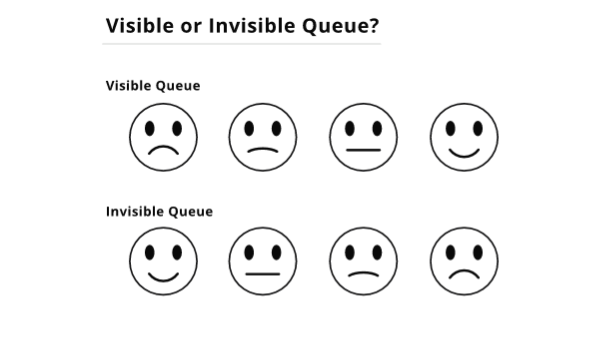Queues are a fact of life—especially now, given staffing shortages and growing workloads in many organizations. All contact centers—even emergency services—queue customers some of the time. Answering every contact immediately would take as many staff as inbound contacts at any given moment.
So, how do customers perceive queues?
First, a note on terminology: Queue comes from the word cue, a term from Old French that means “line of waiting people.” The term is common in everyday British English (less so in North America, where “line” is typical) and appears frequently in contact center terminology. Frustrated customers still tend to say “I’m on hold” rather than the more-precise “I’m in queue.”

The figure above represents customer perceptions of the two major types of queues—visible and invisible. The top row of faces in the figure reflects a queue that customers can “see” (e.g., grocery store, stadium, ride at the county fair). The first face represents how people feel as they enter the queue. As they move forward, the subsequent faces illustrate their progress. The final face reflects the fact that they “made it.”
The second row of faces represents a setting where customers are unaware of the length of the queue they are entering—say, a contact center. Ignorance is bliss, and expectations are initially high. But after some amount of waiting, often 15 or 20 seconds, they begin to doubt that they are going to get right through (second face). The third face illustrates the transition from doubt to mild frustration. By now, they have heard the first and maybe second delay announcement and they know they are in a queue.
The fourth face represents customers who, from their perspective, have waited too long. Often, the first thing they do when they reach an agent is mention the difficulty they had getting through. That lengthens handling time, which will back up the queue even more and cause even more customers to complain to agents—a downward spiral.
And there’s another phenomenon that kicks in here. Customers who have waited a long time in queue tend to “dig in their heels” as they attempt to squeeze all the value out of the interaction that they can: “Um, let me ask one more question while I have you.” Continue reading.
Continue reading my article “The Psychology of Queues” published on ICMI’s website.



0 Comments